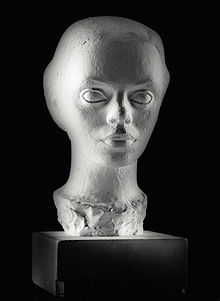Faroese art

The Faroese art originated in the 20th century and is heavily inspired by the Faroese landscape and island life. By the 1930s at the latest , a number of Faroese visual artists were able to establish themselves, some of whom also learned, lived and worked in Denmark .
Faroese culture has a very long tradition since the Middle Ages . The typical forms of expression were over the centuries, only the chain dance with the associated ballads that were transmitted orally and thus the survival of the Faroese language allowed until the 19th century , the Faroese literature could develop.
In addition to the dramatic nature, the old myths , fairy tales and legends handed down in the ballads provide further topics of modern visual art on the North Atlantic archipelago.
First generation artists
With the national awakening movement towards the end of the 19th century and the associated national and romantic currents in intellectual life, people began to be interested in the landscape and its representation in addition to their own language and literature. The first painters were amateurs who painted mountains, villages, the sky and the sea. But folk motifs also played a role. They were inspired by the Scandinavian romantics of the 19th century, and the first generation of professional and semi-professional artists can also be classified as romantic.
William Heinesen (1900–1991) can be described as the “father” of the Faroese cultural scene in the 20th century. He was not only an internationally known writer and poet, but also a visual artist. His work ranges from book illustrations to paintings to his characteristic silhouette. Its satirical and humorous undertones, which were intended to inspire other artists, were often characteristic.
Mikines (1906–1979) is considered the first professional and at the same time one of the most important painters in the Faroe Islands. Together with Heinesen, he organized the first art exhibition in the capital Tórshavn in 1927 .
Ruth Smith (1913–1958) was a particularly sensitive painter who captured the Faroese light like no other. Two of her self-portraits are among the most important Faroese paintings.
Janus Kamban (1913–2009) is the leading sculptor in the Faroe Islands. Clear and calm shapes also characterize his graphic work. Frimod Joensen (1914–1997) painted its natural surroundings as part of a great story, while the graphic artist Elinborg Lützen (1919–1995) made fairy tales, myths and legends the content of her works. Finally, Jóannis Kristiansen (1918–1988) is counted among the few Faroese impressionists .
Second generation artists
After the Second World War , the Faroe Islands not only achieved the long-awaited extensive autonomy, but they also had a rich art scene that continued to focus mainly on expressionist landscape painting. The main motif were the Faroese villages . Over the years, the visual arts became more and more experimental. The cultural center is Tórshavn , and measured against the number of inhabitants in the Faroe Islands, a surprising number of people live here from their art. Painting plays a key role in Faroese culture today.
Ingálvur av Reyni (1920–2005) is the Faroese artist who has distanced himself furthest from representational painting and can be regarded as a representative of abstract art . His friend Hans í Mikladali (1920–1970) wanted to go high with large frescoes and mosaics. Illness and his early death prevented him from realizing his major projects.
Steffan Danielsen (1922–1976) is considered to be in a "class of its own" with the very peculiar melancholy interpretations of the landscape on his home island of Nólsoy .
Zacharias Heinesen's (* 1936) art deals mostly with village motifs in a decorative-expressionist way. Every Faroese and visitor knows the Faroese banknotes whose backs they have designed. The church in Husum adorns an altarpiece by him. This makes him the only artist from the Faroe Islands who is permanently immortalized in Germany with one of his works.
Thomas Arge (1942–1976) demonstrated in his short life that the Faroese landscape has many aspects in store that have not been shown before. Olivur við Neyst (* 1953) presents his hometown Klaksvík in cubist pictures. Tróndur Patursson (* 1944) explores the experimental path in sculpture with unusual materials. He also paints - on glass .
Bárður Jákupsson (* 1943) is considered an all-rounder: painter, author of art books, former director of the Faroe Islands Art Museum , book illustrator and stamp designer. The textile artist Astrid Andreasen (* 1948) also designs postage stamps , as does the graphic artist Anker Eli Petersen (* 1958), from whom all the maps of the Faroe Islands used here at Wikipedia come. The painter Hanni Bjartalíð , born in Klaksvík in 1968, visited the "Nordiska Konstskolan" in Kokkola and now lives in Lahti (Finland).
literature
- Bárður Jákupsson : Færøernes billedkunst. Hjørring: Atlantia, 2000.
- Ove Mogensen, Ole Jul (ed.): Atlantisk Rapsodi: Billeder af Færøerne . Tønder: Sønderjyllands Kunstmuseum, 2005 - ISBN 87-88383-37-7 (122 pp. Danish and German)
Web links
- The Mermaid Lounge (article on the subject in English)
- Bryggenart.com - Paintings and Basalt (article on the subject in English)
- Art.fo (in English. See also: Faroe Islands Art Museum )
- Faroeartstamps.fo ( Faroese stamps on the subject, also in German)

